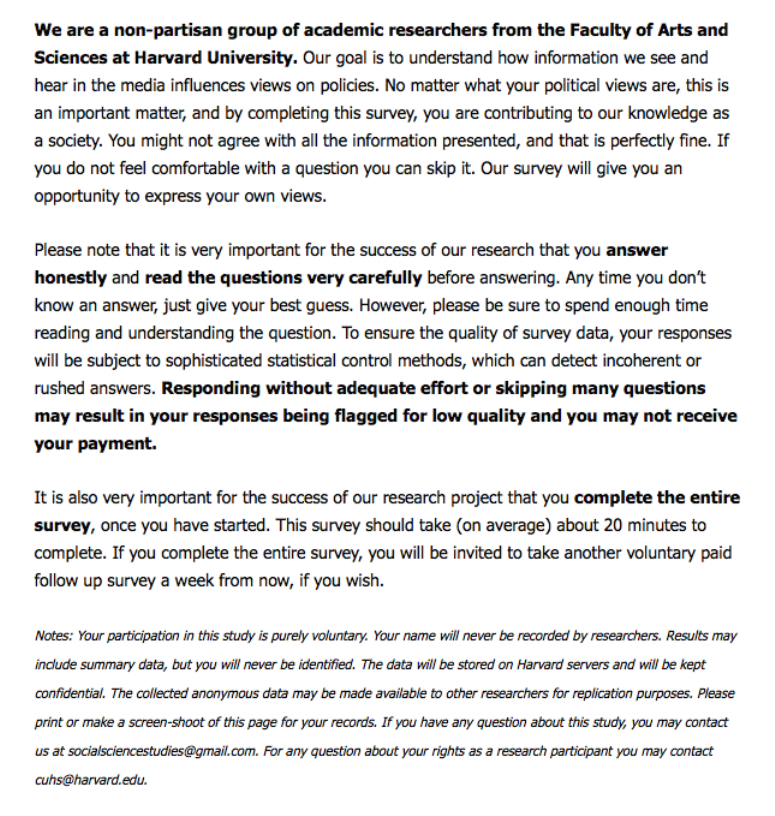
A-4.3 Full U.S. Questionnaire in English
Figure A-1: First page of the survey (English version)
Answer options are in italic, separated by a semicolon.
1. See Figure A-1
Yes, I would like to take part in this study, and confirm that I WAS BORN IN THE U.S. and I am 18
or older; No, I would not like to participate
2. Were you born in the United States?
Yes; No
3. What is your gender?
Male; Female
4. What is your age?
A-16
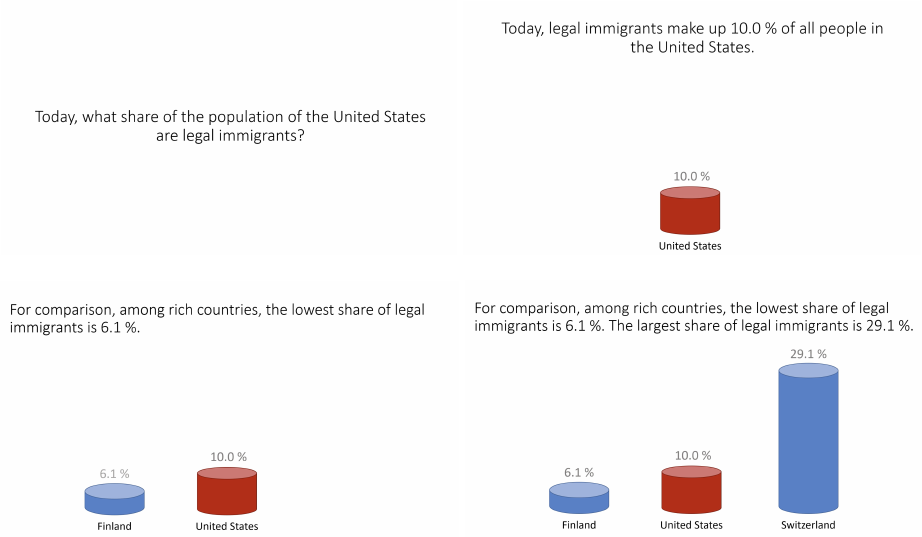
Figure A-2: “Share of Immigrants” Treatment
5. What was your TOTAL household income, before taxes, last year? $0-$9999 ; $10000-$14999 ; $15000-
$19999 ; $20000-$29999 ; $30000-$39999 ; $40000-$49999 ; $50000-$69999 ; $70000-$89999 ; $90000-
$109999 ; $110000-$149999 ; $150000-$199999 : $200000+
6. Please indicate your marital status.
Single; Married; Legally separated or divorced; Widowed
7. How many children do you have?
I do not have children: 1; 2; 3; 4; 5 or more
8. How would you describe your ethnicity/race?
European American/White; African American/Black; Hispanic/Latino; Asian/Asian American; Other
9. Were both of your parents born in the United States?
Yes; No
10. [If Yes to Q9] Where was your father born?
[dropdown menu with list of countries]
11. [If Yes to Q9] Where was your mother born?
[dropdown menu with list of countries]
12. What is your ZIP code?
13. Which category best describes your highest level of education?
Eighth Grade or less; Some High School; High School degree / GED; Some College; 2-year College
Degree; 4-year College Degree; Master’s Degree; Doctoral Degree; Professional Degree (JD, MD, MBA)
A-17
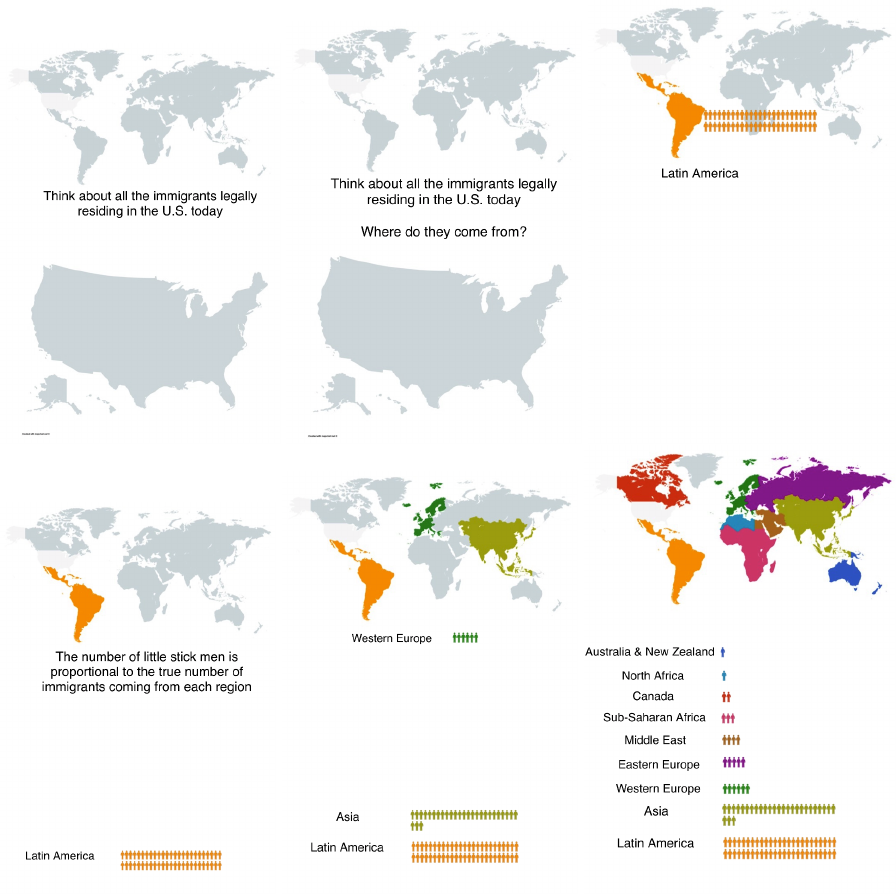
Figure A-3: “Origin of Immigrants” Treatment
14. What is your current employment status?
Full-time employee; Part-time employee; Self-employed or small business owner; Unemployed and look-
ing for work; Student; Not currently working and not looking for work; Retiree
15. [If Full-time employee; Part-time employee; Self-employed or small business owner] Are you employed
in one of the following sectors? Check the one that applies. If you have multiple jobs, check the one
that describes your main occupation.
[See Appendix A-1]
16. [If Unemployed and looking for work; Not currently working and not looking for work; Retiree] Even if
you are not currently working, what sector did your latest occupation fall under? Check the one that
applies. If you have had multiple jobs, check the one that describes your main occupation.
A-18
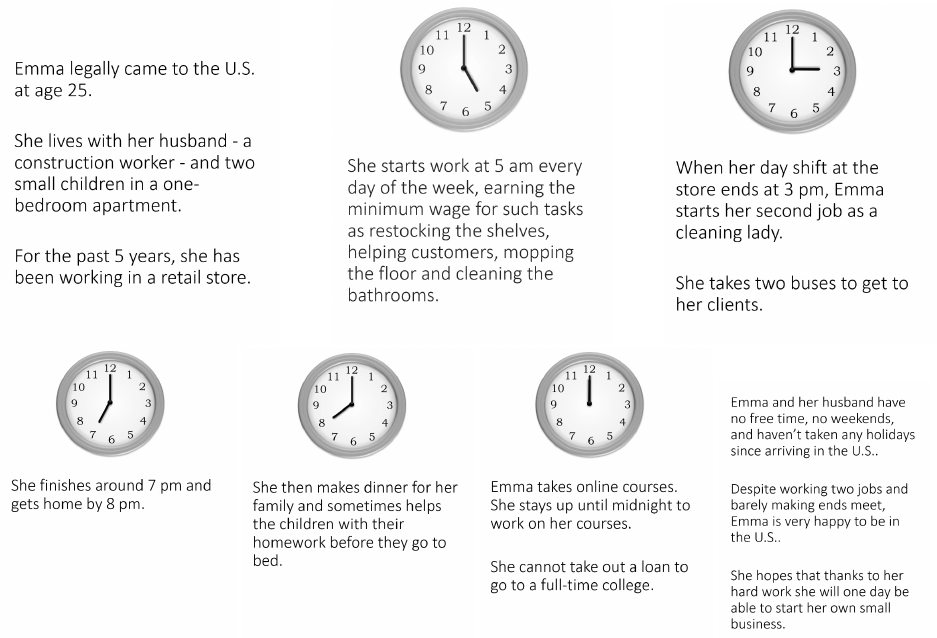
Figure A-4: “Hard Work of Immigrants” Treatment
[See Appendix A-1]
17. On economic policy matters, where do you see yourself on the liberal/conservative spectrum?
Very liberal; Liberal; Moderate; Conservative; Very conservative
18. In politics, as of today, do you consider yourself a Republican, a Democrat or an independent?
Republican; Democrat; Independent
19. Did you vote in the last presidential election?
Yes; No
20. [If Yes to Q19] In the last presidential election, you supported:
Hillary Clinton; Donald Trump; Jill Stein; Gary Johnson
21. [If No to Q19] Even if you did NOT vote, please indicate the candidate that you were most likely to
have voted for or who represents your views most closely
Hillary Clinton; Donald Trump; Jill Stein; Gary Johnson
22. Before proceeding to the next set of questions, we want to ask for your feedback about the responses
you provided so far. It is vital to our study that we only include responses from people who devoted
their full attention to this study. This will not affect in any way the payment you will receive for taking
this survey. In your honest opinion, should we use your responses, or should we discard your responses
since you did not devote your full attention to the questions so far?
A-19
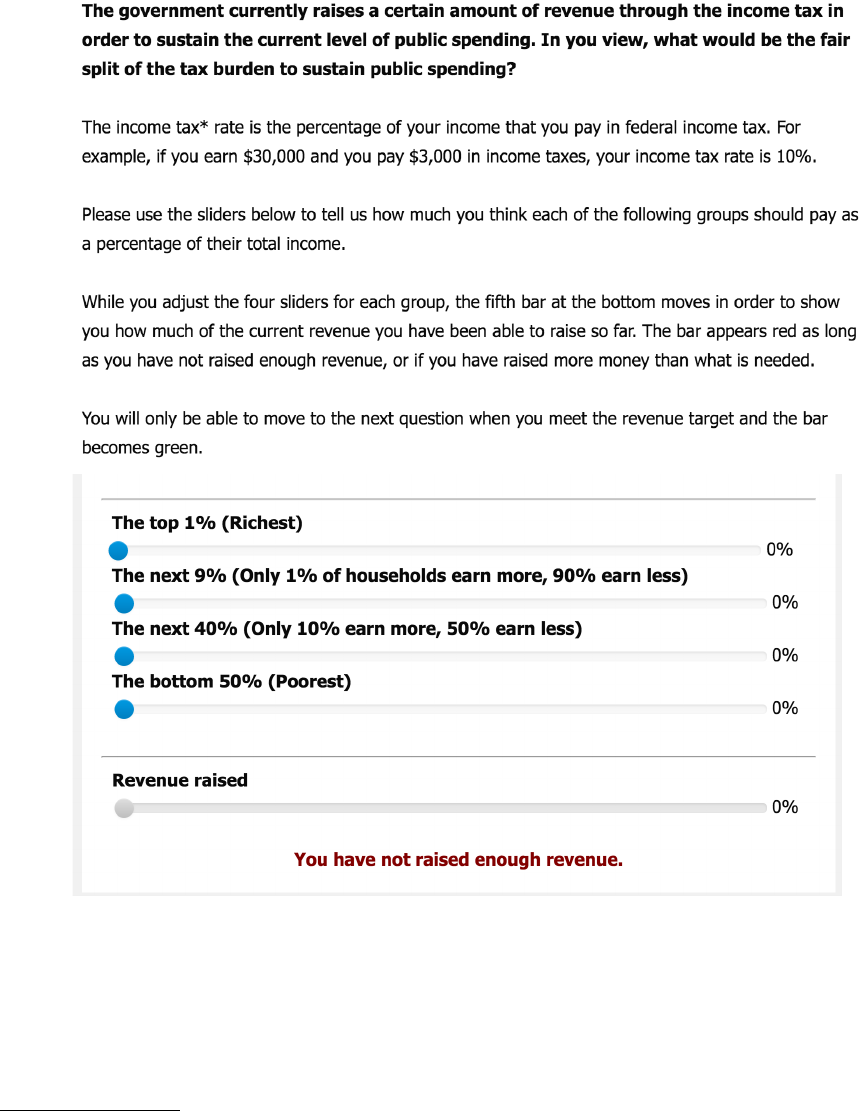
Figure A-5: Question on preferred income tax rates for various income
groups
Yes, I have devoted full attention to the questions so far and I think you should use my responses for
your study; No, I have not devoted full attention to the questions so far and I think you should not use
my responses for your study
Video Treatments
• Control: No video [go directly to Redistribution or Immigration Block]
• Share of immigrants: See Figure A-2
A-20
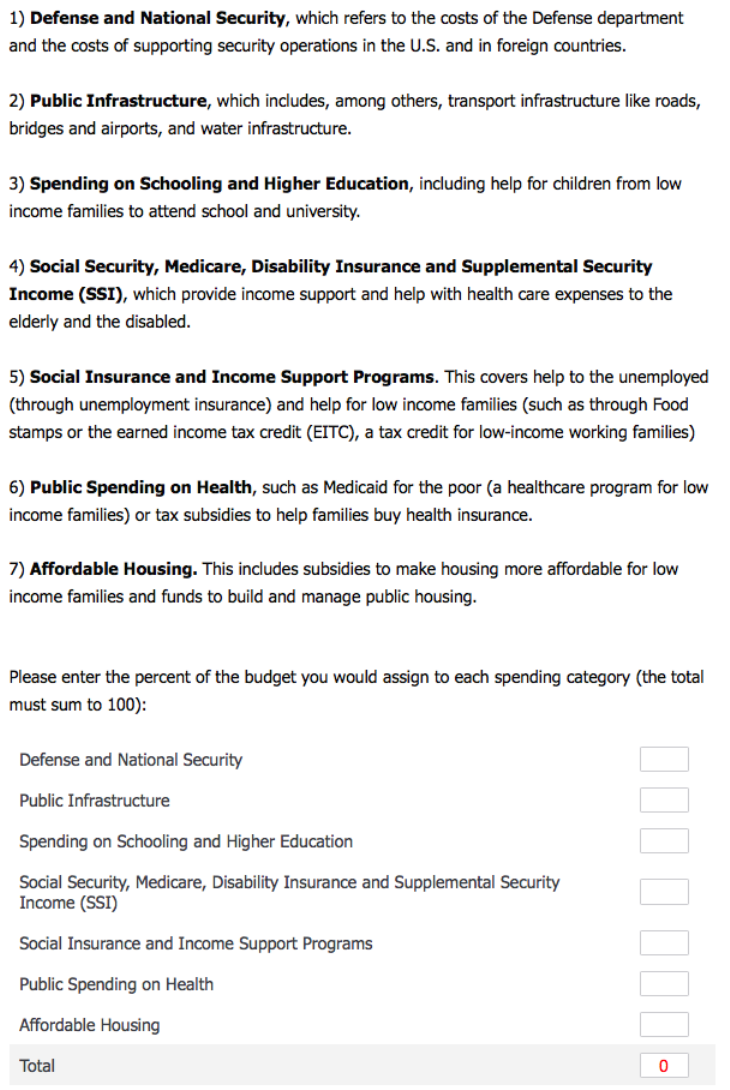
Figure A-6: Question on preferred allocation of government budget
• Origins of immigrants: See Figure A-3
• Hard work of immigrants: See Figure A-4
A-21

Redistribution Block
In the next two questions, we ask you to think about the total level of funds that the government
raises and spends today on various policies. For the purpose of these questions, suppose that the level
of government spending is fixed at its current level and cannot be changed. We will ask about your
views on two aspects: a. First, on the fair split of the tax burden to raise these funds; b. Second, on
how you think the government should spend these funds.
23. See Figure A-5
24. See Figure A-6
25. Do you think income differences between rich and poor people are:
Not a problem at all; A small problem; A problem; A serious problem; A very serious problem
26. To reduce income differences between rich and poor people, the government (at the local, state, or
federal level) has the ability and the tools to do:
Nothing at all; Not much; Some; A lot
27. Some people think that the government (at the local, state, or federal level) should not care about
income differences between rich and poor people. Others think that the government should do every-
thing in its power to reduce income inequality. Rate on a scale of 1 to 7 on how you feel about this
issue, with 1 being the government should not concern itself with income inequality and 7 being the
government should do everything in its power to reduce income inequality.
Here are several things that the local, state, or federal government might do to reduce income differences
between rich and poor people. Please indicate if you favor or oppose them. Keep in mind that, in
order to finance an expansion of any of these, other types of spending (like spending on infrastructure
and defense, for example) would have to be scaled down or taxes would have to be raised.
28. Would you say that you strongly favor, favor, neither favor nor oppose, oppose or strongly oppose
spending more money on schools in poor neighborhoods?
Strongly favor; favor; neither favor nor oppose; oppose; strongly oppose
29. Would you say that you strongly favor, favor, neither favor nor oppose, oppose strongly oppose spending
more money to provide decent housing for those who cannot afford it?
Strongly favor; favor; neither favor nor oppose; oppose; strongly oppose
30. Would you say that you strongly favor, favor, neither favor nor oppose, oppose or strongly oppose
increasing income support programs for the poor?
Strongly favor; favor; neither favor nor oppose; oppose; strongly oppose
31. How much of the time do you think you can trust our federal government to do what is right?
Almost always; A lot of the time; Not very often; Almost never
32. By taking this survey, you are automatically enrolled in a lottery to win $1000. In a few days you will
know whether you won the $1000. The payment will be made to you in the same way as your regular
survey pay, so no further action is required on your part. In case you won, would you be willing to
donate part or all of your $1000 gain for a good cause? Below you will find 2 charities which help
people in the U.S. deal with the hurdles of everyday life. You can enter how many dollars out of your
$1000 gain you would like to donate to each of them. If you are one of the lottery winners, you will
be paid, in addition to your regular survey pay, $1000 minus the amount you donated to charity. We
will directly pay your desired donation amount to the charity or charities of your choosing. Enter how
much of your $1000 gain you’d like to donate to each charity:
Feeding America: ... ; The Salvation Army: ...
A-22
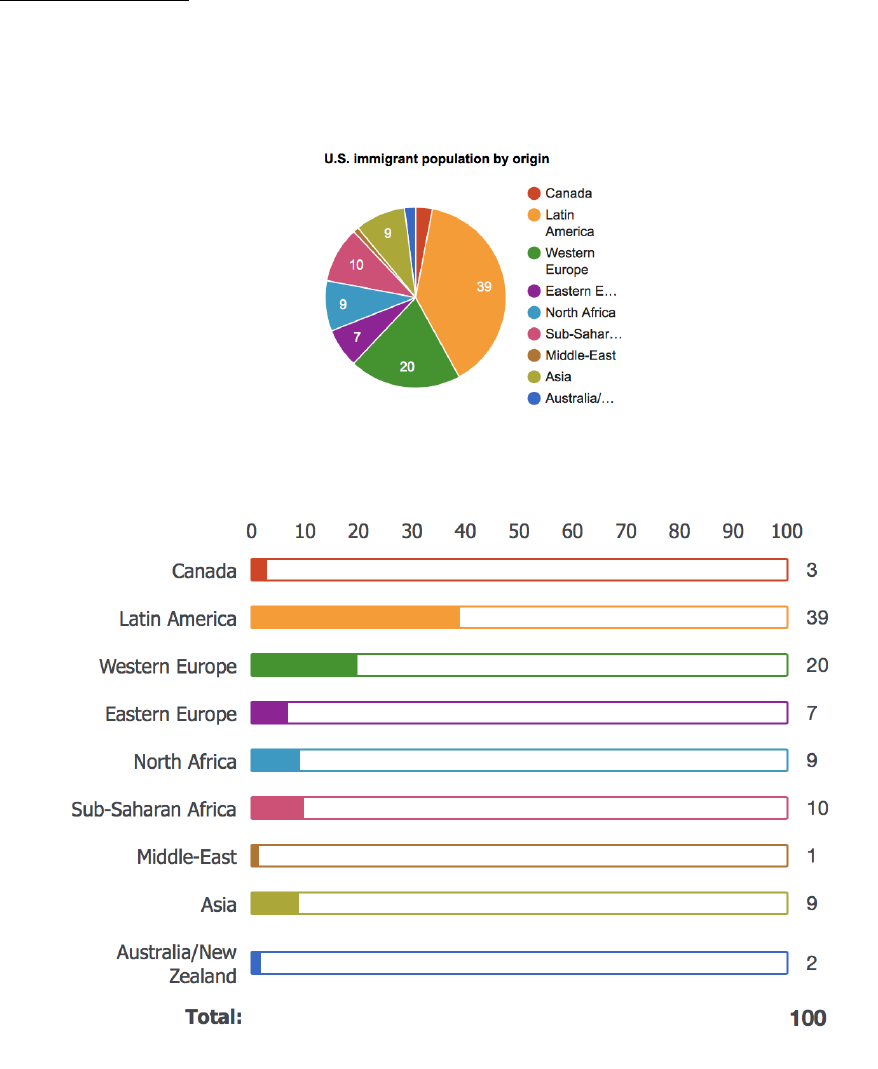
Immigration Block
In what follows, we refer to immigrants as people who were not born in the U.S. and legally moved
here at a certain point of their life. We are NOT considering illegal immigrants.
Figure A-7: Eliciting Perceptions on the Origin of Immigrants
33. See Figure 1
34. The map here shows you the main regions of the world. The pie chart below represents all legal
IMMIGRANTS currently living in the U.S.. Where do you think these immigrants come from? Move
the sliders to indicate how many out of every 100 immigrants come from each region, in your opinion.
As you move the sliders, the pie chart will adjust to show your responses, reflecting the colors of the
various regions, as in the map. (Your responses must add up to 100)
A-23
[See Figure A-7]
35. Think again about all of the legal immigrants currently living in the U.S.. What do you think is their
religion? Fill in the boxes below to indicate how many out of every 100 immigrants you think practice
each religion.
Christianity ...; Islam ...; Buddhism ...; Hinduism ...; Other Religions/Atheist ...
36. Out of every 100 people born in the U.S. how many are currently unemployed? By unemployed we
mean people who are currently not working but searching for a job (and maybe unable to find one).
Now let’s compare this to the number of unemployed among legal immigrants. Out of every 100 legal
immigrants how many do you think are currently unemployed?
37. Out of every 100 people born in the U.S., how many have at least a two-year college degree?
Now let’s compare this to the number of college-educated legal immigrants. Out of every 100 immi-
grants in the U.S. today how many do you think have at least a two-year college degree?
38. Out of every 100 people born in the U.S., how many have not completed high school?
Out of every 100 legal immigrants in the U.S. today how many do you think have not completed high
school?
39. Out of every 100 people born in the U.S., how many live below the poverty line? The poverty line is
the estimated minimum level of income needed to secure the necessities of life.
Let’s compare this to poverty among legal immigrants. Out of every 100 legal immigrants in the U.S.
today, how many do you think live below the poverty line?
40. Some people think that the government (at the local, state, or federal level) should only support people
who were born in the U.S.. Others think that the government should care equally about all the people
living in the country, regardless of their country of origin and regardless of whether they are born in
the U.S.. Rate on a scale of 1 to 7 on how you feel about this issue, with 1 being the government
should focus on supporting people born in the U.S. and 7 being the government should care equally
about everyone.
41. What is your view on the number of legal immigrants from foreign countries who are permitted to
come to the United States to live? Pick the answer that best reflects your view.
The excessive number of legal immigrants today is a very big problem. We should ask many legal
immigrants to leave the country and we should stop accepting new immigrants; The number of legal
immigrants today is a big problem and we should decrease by a lot the number permitted to come to
the U.S. in the future; The number of legal immigrants today is somewhat of a problem and we should
try and decrease a bit the number permitted to come in; The number of legal immigrants today is not
a problem. We should keep letting in the same number of immigrants each year as until now; The
number of legal immigrants today is not a problem at all. We should let even more legal immigrants
come live in the U.S. and increase the number that is permitted to come every year
42. In your view, how soon after arriving should immigrants be entitled to government assistance such as
Medicaid, food stamps, or welfare on the same basis as citizens?
Immediately, as soon as they arrive; 1 year after; 3 years after; 5 or more years after; only after they
receive citizenship; never
43. As you may know, once immigrants who come into the country receive U.S. citizenship, they are allowed
to vote in all local, state, and federal elections. In your view, when should immigrants who come into
the country legally be allowed to apply for U.S. citizenship?
2 years after arriving; 5 years after arriving; 10 years after arriving; 20 years after arriving; They
should never be allowed to apply for citizenship
A-24
44. Suppose someone is not born in the United States but now lives here. At what point would you consider
this person to be “American”?
Immediately, as soon as he arrives; After he has spent 5 years in the U.S.; After he has spent 10 years
in the U.S.; It depends on where he comes from; As soon as he gets citizenship; I would never consider
him to be American, but if his kids were born in the U.S. I would consider them truly American; I
would not consider him or his kids to ever be truly American
45. Which has more to do with why an immigrant living in the U.S. is poor?
Lack of effort on his or her own part; Circumstances beyond his or her control
46. Which has more to do with why an immigrant living in the U.S. is rich?
Because she or he worked harder than others; Because she or he had more advantages than others
47. U.S. born residents receive government transfers in the form of public assistance, Medicaid, child
credits, unemployment benefits, free school lunches, food stamps or housing subsidies when needed.
How much do you think each legal immigrant receives on average from such government transfers? An
average immigrant receives...
No transfers; One third as much as a U.S. born resident; Half as much as a U.S. born resident; As
much as a U.S. born resident; Slightly more than a U.S. born resident; Twice as much as a U.S. born
resident; Three times as much as a U.S. born resident; More than ten times as much as a U.S. born
resident
48. Imagine two people, John and Mohammad, currently living in the U.S. with their families. John is
born in the U.S., while Mohammad legally moved to the U.S. five years ago. They are both 35, have
three children, and earn the same low income from their jobs. In your opinion, does Mohammad pay
more, the same, or less in income taxes than John?
A lot more; More; same; less; a lot less
49. In your opinion does Mohammad, who is an immigrant, receive more, the same, or less government
transfers (such as e.g., public assistance, Medicaid, child credits, unemployment benefits during unem-
ployment spells, free school lunches, food stamps or housing subsidies) than John?
A lot more; More; same; less; a lot less
50. Do you have any friends or acquaintances who were born outside the U.S.?
Yes; No
51. [If Yes to Q50] Where do they come from? (check all that apply)
Canada; Latin America; Western Europe; Eastern Europe; North Africa; Sub-Saharan Africa; Middle-
East; Asia; Australia/New Zealand
52. Do you feel that this survey was biased?
Yes, left-wing bias; Yes, right-wing bias; No, it did not feel biased
A-4.4 Charities Listed for the Donation Question
We report here the charities we listed in the donation question in each country. See Q32 in Appendix A-4.3
for the exact wording of the question.
• U.S.: Feeding America, The Salvation Army
• U.K.: Save the Children U.K., The Salvation Army
• France: Les Restos du Cœur, Emma¨us
• Germany: SOS Kinderdorf, Tafel
A-25
• Italy: Caritas, Save the Children Italia
• Sweden: Fr¨alsningsarm´en, Majblomman
A-5 Summary of Perceptions and Misperceptions
A-26
